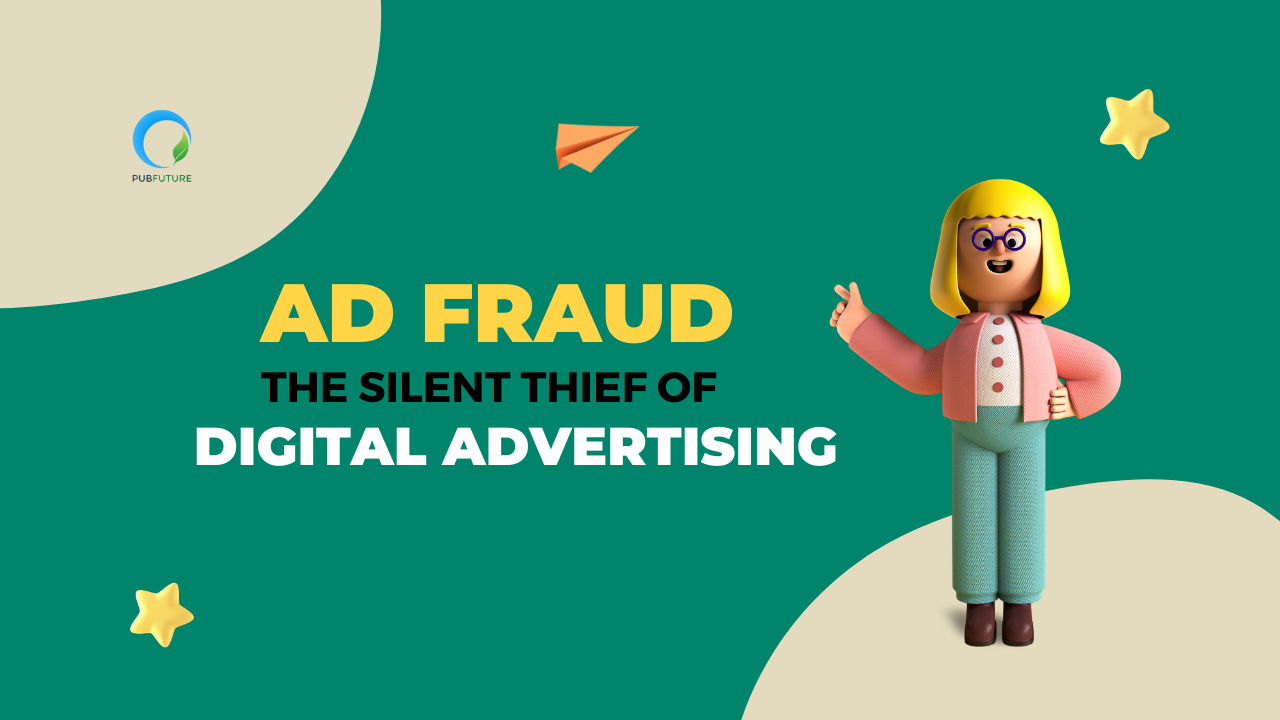Online advertising is massive, and ad frauds are equally significant.
Web publishers have experienced their payments being held back or their accounts being suspended by a monetization partner due to invalid traffic and the quality of ads, whether real or suspected.
Programmatic advertising allows advertisers and publishers of any size to join an open ecosystem. However, due to the massive scale of this operation, there are individuals who will inevitably exploit the system for benefit.
Ad fraud has been around for quite some time, with the earliest cases of Pay-Per-Click (PPC) fraud dating back to 2001. What has changed is the magnitude of ad fraud today. Resulting in the ad tech industry facing billions of dollars in projected losses each year.
It’s essential for publishers to understand the various ad fraud tactics to prevent it. Our guide covers the impact of ad fraud, the most common types of ad fraud, and steps to protect themselves.

What Is Ad Fraud?
Ad fraud involves tricking advertising platforms into believing that fake activity on the network is genuine user behavior. Usually, malicious individuals rely on bots to carry out ad fraud. Some involve actual people that scammers use to get paid by advertisers and ad networks for fake engagement.
Ad fraud is an effort to hinder the accurate delivery of ads to real users and the intended target audience.
Types of Ad Fraud
Marketers should be aware of various ad fraud types, including bots posing as humans, fake engagement spamming, click farms, and others. These are some of the most prevalent forms of ad fraud.

Click Fraud
Click fraud occurs when individuals or bots intentionally click on an advertiser’s PPC ad without any intention of purchasing the advertised product. As a result, companies end up spending additional funds to display ads on the website, unknowingly paying the fraudsters. This can have consequences if advertisers discover the fraudulent activity and choose to stop their ads.
Domain Spoofing
Domain spoofing is the act of deceiving advertisers by presenting a counterfeit website that imitates a reputable and often in-demand site. In this scheme, fraudsters manipulate advertisers into paying high fees for advertising space of subpar quality.
SDK Spoofing
SDK spoofing is the act of developing a bot within an application to generate false clicks and app installations. This deceptive technique, also referred to as traffic spoofing, can deceive advertisers into paying for app installations that never actually occurred, sometimes even in the tens of thousands.

An example of SDK spoofing is the notorious DrainerBot, a malicious software that produced video ad views without the awareness of device users. It is estimated that apps containing DrainerBot were downloaded over 10 million times.
Ad Injection
Fraudulent ads are surreptitiously inserted onto a publisher’s website unbeknownst to them, either replacing the existing ads or appearing alongside legitimate ones.
Ad injection typically occurs through compromised browser extensions, plug-ins, and various forms of malware.
Detecting such activity can prove challenging, as numerous widely-used security tools primarily concentrate on monitoring the server-side, while injected ads are introduced through the client-side of the connection.
Ad Stacking
Scammers use this mobile ad fraud variant to hide ads. They stack multiple ads on top of each other, but only one is visible to users. Although all ads in the stack may have real impressions, users won’t see the content, resulting in the advertiser not receiving any value.
Pixel Stuffing
Pixel stuffing is the process of converting individual pixels into ad space, as the name implies. This technique involves inserting an ad into a minuscule area, typically measuring 1×1 pixel, which allows for the recording of impressions.
Despite being practically invisible to visitors, the ad is still able to generate impressions. Similar to ad stacking, pixel stuffing empowers fraudsters to place a significantly higher number of ads on a website than would be feasible otherwise.
Geo Masking/Location Fraud
The discrepancy in the value of traffic across different countries is widely known. The Cost per Thousand Impressions (CPMs) can significantly vary depending on the geographical location of the traffic. Unfortunately, fraudsters take advantage of this situation by concealing the origin of their traffic and then deceiving advertisers into purchasing unvaluable traffic at inflated prices.
Install Farms
Scammers employ bots or emulators to simulate genuine users, creating the illusion of real software installations while no actual viewers witness the ads.

Forced Redirect Ads
Malicious individuals can exploit online ad fraud to pilfer revenue and to distribute malware by inserting a malevolent ad or iframe. This leads the users to a different website with the intention of stealing their personal information.
How Does Ad Fraud Affect Publishers?
Publishers are impacted by ad fraud in various ways. The revenue that should be going to publishers is being claimed by fraudsters, as seen in cases of ad injection.
This not only results in a decrease in income but can also harm the relationships that publishers have established with advertisers and clients.
How Does Ad Fraud Affect Advertisers?
Ad spend is clearly squandered due to ad fraud, which is projected to result in a loss of $44 billion for advertisers. However, the impact of ad fraud on advertisers extends far beyond their financial statements.
Consider the ad agency, who may be attempting to measure the success of one of their advertising campaigns. Unfortunately, the campaign has been plagued by ad stacking, which has made it exceedingly challenging to make an accurate evaluation. Despite receiving numerous impressions, the campaign’s ads have garnered relatively few clicks due to the ad stacking.
The team might think that the campaign’s initial message was not successful, so they decided to change it. However, if the ad had reached its intended audience, it could have been effective. This situation results in wasting more money and time. Additionally, ad fraud can also erode the trust of the broader community in the digital advertising industry.
How to Prevent Ad Fraud?
Due to the various forms of ad fraud, no singular strategy can adequately safeguard your inventory. To effectively prevent such fraudulent activities, it is crucial to establish safety measures that enable early identification of abnormal behavior. Additionally, actively collaborating with a reputable ad provider is essential in maintaining proactive measures.
Research Ad Network
Knowing your business partners is the first step towards mitigating the risk of ad fraud. You should look for an ad network that has a transparent and strict platform, including fraud detection and prevention capabilities.
Maintain an Ads.txt File
Possess an ads.txt file that declares the ad networks, exchanges, and supply side platforms (SSPs) authorized to resell your ad content. Additionally, verify if your monetization partner hosts a valid sellers.json file, which allows advertisers to authenticate the source of the ad space and impressions.
Block Risky IP Addresses
To combat click fraud, implementing an IP blacklist within Google Ads can prove to be a successful strategy. Once any questionable clicks are detected, simply add the corresponding IP addresses to the blacklist to prevent them from accessing your ads in the future.
Know Your Metrics
The initial stage in detecting ad fraud is to have a thorough understanding of your metrics. Without the ability to recognize the problem, it becomes impossible to effectively address it. Familiarizing yourself with the standard CTRs, bounce rates, and conversion rates enables you to pinpoint any irregularities as they arise. For instance, if your PPC volume experiences a drastic 1,000% increase and your CTR triples, yet your call volume remains unchanged, it is likely indicative of an issue.
Keep an eye out for copyright theft
To prevent others from making money off of your website’s plagiarized content, create Google alerts for exact matches or use Copyscape to track your content online. If someone is infringing on your copyright, send them a DMCA takedown notice.
Ask Your Users for Feedback
Ad fraud, including ad injections, may pose a challenge for site owners to detect, it can be relatively simpler for visitors. Hence, it is advisable to facilitate an effortless feedback mechanism for your website’s visitors to report any issues with your pages and advertisements.
Final Thoughts
To ensure the effectiveness of advertising campaigns, marketers must ensure that their ad spend is reaching targeted users. The problem of online advertising fraud remains a major concern for ad networks and advertisers.
Acquiring knowledge about ad fraud and their functioning can enable you to establish preventive measures against ad fraud.








